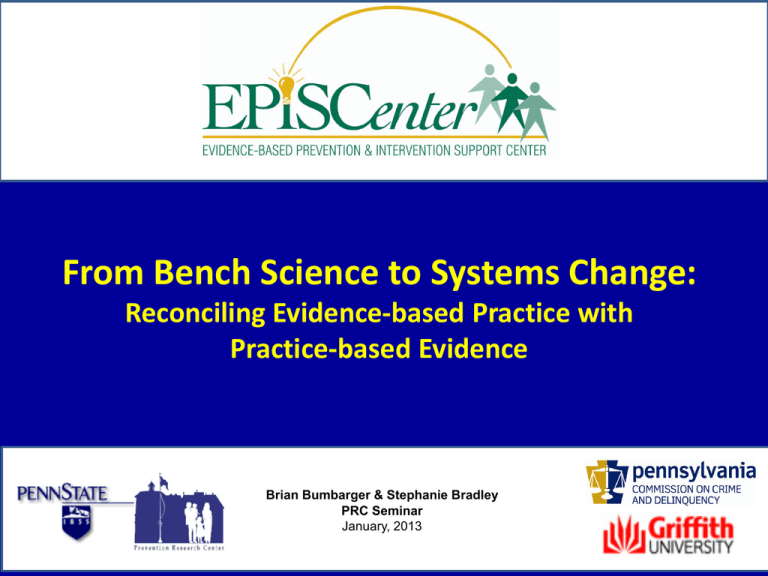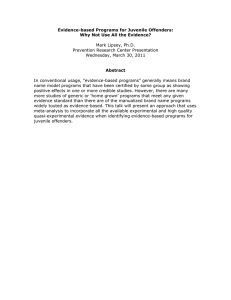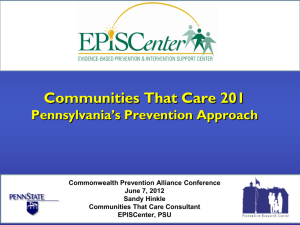From Bench Science to Systems Change: Reconciling Evidence-based Practice with Practice-based Evidence
advertisement

From Bench Science to Systems Change: Reconciling Evidence-based Practice with Practice-based Evidence Brian Bumbarger & Stephanie Bradley PRC Seminar January, 2013 Investigators and Authors: Brian Bumbarger Mark Feinberg Louis Brown Michael Cleveland Jennifer Sartorious Brendan Gomez Stephanie Bradley Mark Greenberg Brittany Rhoades Wayne Osgood Damon Jones Julia Moore Richard Puddy Elizabeth Campbell Collaborative Policy Innovators: Mike Pennington Clay Yeager James Anderson Keith Snyder The EPISCenter and research described here are supported by grants from the Pennsylvania Commission on Crime and Delinquency. Special thanks to the staff of the Office of Juvenile Justice and Delinquency Prevention (OJJDP) 2 We know a great deal about how youth problems develop, and how to effectively prevent them (& reduce prevalence) • Known risk & protective factors • Multiple domains of influence (community, family, school, peer, individual) • Multifinality and equifinality (a public health approach to public safety) • Different trajectories (early vs. late starters) • Criminogenic impact of intervention From Lists to Improved Public Health… • Synthesis and translation of research to practice, (and practice to research) • EBP dissemination, selection, and uptake • Ensuring sufficient implementation quality and fidelity • Understanding adaptation and preventing program drift • Measuring and monitoring implementation and outcomes • Policy, systems, and infrastructure barriers • Coordination across multiple programs and developmentally • Sustainability in the absence of a prevention infrastructure Bumbarger, B. and Perkins, D. (2008). After Randomized Trials: Issues related to dissemination of evidence-based interventions. Journal of Children’s Services,3(2), 53-61. Bumbarger, B., Perkins, D., and Greenberg, M. (2009). Taking Effective Prevention to Scale. In B. Doll, W. Pfohl, & J. Yoon (Eds.) Handbook of Youth Prevention Science. New York: Routledge. Moving From Prevention Science . . . Implement & Evaluate Programs Develop & Test Interventions Identify Risk & Protective Factors Define the Problem Problem Response …To Prevention Service Provide Technical Assistance Set & Collect Performance Measures Monitor Quality of Program Implementation Assess Public Health Impact Response Pennsylvania’s EBP Dissemination Model • Prevent dependency, delinquency, and ATOD use to the greatest degree possible (primary prevention) • Intervene effectively with youth for whom primary prevention is not sufficient • Allow communities flexibility to select strategies that best meet local needs • Create community-level infrastructure for strategic prevention planning and coordination • Provide accountability and use scarce resources efficiently ULTIMATELY…. • To “move the needle” on key indicators of (behavioral) health at the POPULATION level 9 Multi-Agency Steering Committee (Justice, Welfare, Education, Health) Intermediary and State-level Prevention Support System Support to Community Prevention Coalitions Support to Evidence-based Programs Improve Quality of Local Innovative Programs and Practices A unique partnership between policymakers, researchers, and communities to bring science to bear on issues of public health and public safety The EPISCenter is a project of the Prevention Research Center, College of Health and Human Development, Penn State University, and is funded by the Pennsylvania Commission on Crime and Delinquency and the Pennsylvania Department of Public Welfare as a component of the Resource Center for Evidence-Based Prevention and Intervention Programs and Practices. The Menu of EBPs in This Project* • Olweus Bullying Prevention Program (OBPP) • Promoting Alternative Thinking Strategies (PATHS) • Big Brothers Big Sisters of America (BBBS) • Multidimensional Treatment Foster Care (MTFC) • Strengthening Families Program 10-14 (SFP) • Project Towards No Drug Abuse (Project TND) • Life Skills Training (LST) • Incredible Years (IYS) • Functional Family Therapy (FFT) • Multisystemic Therapy (MST) • Aggression Replacement Training (ART) Multifinality: Equifinality: There are Poor known outcomes risk are factors, associated each of which with a iscombination associated of risk with a factors range ofand poor developmental outcomes pathways Creating Fertile Ground for EBPs Risk-focused Prevention Planning (the Communities That Care model) Form local coalition of key stakeholders Re-assess risk and protective factors Collect local data on risk and protective factors Leads to community synergy and focused resource allocation Select and implement evidence-based program that targets those factors Use data to identify priorities Pennsylvania’s CTC coalitions 2012 Multi-Agency Steering Committee (Justice, Welfare, Education, Health) Intermediary and State-level Prevention Support System Support to Community Prevention Coalitions Support to Evidence-based Programs Creating “fertile ground” for EBP selection and adoption Improve Quality of Juvenile Justice Programs and Practices Multi-Agency Steering Committee (Justice, Welfare, Education, Health) Intermediary and State-level Prevention Support System Support to Community Prevention Coalitions Support to Evidence-based Programs Ensuring high-quality implementation and sustainability Improve Quality of Juvenile Justice Programs and Practices Pennsylvania’s EBP dissemination in 1999… Pennsylvania’s EBP dissemination in 2012… Measuring Population-level Impact • Cross-sectional quasi-experimental study of 98,000 students in 147 communities • Used propensity score matching to minimize potential selection bias • Found youth in CTC communities reported lower rates of risk factors, substance use, and delinquency than youth in similar non-CTC communities (7x as many as by chance) • Communities using EBPs showed better outcomes on twice as many R/P factors and behaviors (14x as many as by chance) 5 year Longitudinal Study of PA Youth % Change of CTC/EBP Youth Over Comparison Group 419 age-grade cohorts over a 5-year period: youth in CTC communities using EBPs had significantly lower rates of delinquency, greater resistance to negative peer influence, stronger school engagement and better academic achievement 40 33.2 30 20 16.4 10 0 -10.8 -10.8 -10 -20 Delinquency Nega ve Peer Influence Academic Performance School Engagement Feinberg, M.E., Greenberg, M.T., Osgood, W.O., Sartorius, J., Bontempo, D.E. (2010). Can Community Coalitions Have a Population Level Impact on Adolescent Behavior Problems? CTC in Pennsylvania, Prevention Science. Impact on Juvenile Court Placement Rates: Comparison of Placement Rates for Counties* With and Without an EBI 11.00 10.50 10.53 10.00 10.05 9.89 9.50 9.76 No EBI 9.00 9.07 8.50 8.70 Adopted EBI 8.00 7.50 7.79 7.78 2009 2010 7.00 2007 2008 Bumbarger, B. K., Moore, J., & Rhoades, B. (2010). Impact of evidence-based interventions on delinquency placement rates. Presentation at 2011 Society for Prevention Research annual meeting. Washington, DC. Justice Reinvestment Realized 24 Pennsylvania’s EBP dissemination in 2012… Programs/services can be placed along a continuum of confidence based on their evidence or theory *Bumbarger & Rhoades, 2012 Ineffective “This program has been evaluated and shown to have no positive or negative effect” Very Confident HARMFUL Ineffective Iatrogenic (Harmful) “This program has been rigorously evaluated and shown to be harmful” Best Practices Research-based “We’ve done it and we like it” unknown “This program is based on sound theory informed by research” Promising Promising Approaches “We really think this will work… but we need time to prove it” EFFECTIVE Very Confident Evidence-based “This program has been rigorously evaluated and shown to work” How confident are we that this program or practice is a good use of resources AND improves outcomes for children and families? 26 Multi-Agency Steering Committee (Justice, Welfare, Education, Health) Intermediary and State-level Prevention Support System Support to Community Prevention Coalitions Support to Evidence-based Programs Improve Quality of Juvenile Justice Programs and Practices Developing “practicebased evidence” A 2-pronged approach… Promoting Evidence-based Programs Developing Practice-based Evidence • Theoretically-based • Not an EBP for every community need/context • Demonstrated effects (confidence) • Sponsored lists – E.g., Blueprints • Funding requirements • Many programs/services already in widespread use • Some of those may be effective • Local expertise/fit Background • More than one way to establish “evidence-based practice”: 1. Model program implementation 2. Evaluation of local program 3. Meta-analysis of research on program “types” Background • Generic intervention types abundant in juvenile justice • Research shows some types effective at reducing recidivism • Main disadvantage of generic programs is they… “lack the specificity that comes with the protocol for a model program and the associated training and support systems that are also often available from the developer” (p. 3). Howell, J.C., & Lipsey, M. W. (2012) Research-based guidelines for juvenile justice programs. Justice Research and Policy, (14) 1, p.1-18. Integrated Meta-analysis of Program Types • Mark Lipsey, Peabody Research Institute, Vanderbilt Univ. • 548 studies - program impact on recidivism • Juveniles aged 12-21, in programs to reduce delinquency • Most effective program types? Characteristics of them? Lipsey, M. W. (2009). The primary factors that characterize effective interventions with juvenile offenders: A meta-analytic overview. Victims and Offenders (4), 124-147. Meta-analysis Results Howell, J.C., & Lipsey, M. W. (2012) Research-based guidelines for juvenile justice programs. Justice Research and Policy, (14) 1, p.1-18. Meta-analysis Results • Four factors most strongly related to recidivism reduction: • Program type: therapeutic vs. control-oriented • Quality of service delivery: clear protocol, monitoring, staff training • Amount of service: duration and total contact hours • Risk: greater impact with higher risk youth Youth Level of Risk (25pts): Service/program groups (35pts): % of youth served at target risk 1. Individual counseling, jobYouth Level of Service (YLS) training 42 item, Quality ofinterview-based Service Delivery (20pts): 2. Community service, remedial Riskacademics factors assessed: 1. Written Program Protocol •Amount Prior & current offenses 3. Family skills of couns., Service social (20pts): •2. Family circumstances/Parenting Staff Training training, challenge programs • of Education/Employment % youth meeting targets for 3. Staff Supervision •4. Peer Relations Group counseling, mentoring, 1. Duration (10pts) •4. Substance Use Response to Drift contingency mgmt • Leisure/Recreation 2. Contact Hours (10pts) • Personality/Behavior 5. Cognitive-behavioral therapy • Attitudes/Orientation Example: Mentoring Target weeks: 26 Target hours: 78 SPEP Score Validity *Quality of service delivery not scored in this sample. Howell, J.C., & Lipsey, M. W. (2012) Research-based guidelines for juvenile justice programs. Justice Research and Policy, (14) 1, p.1-18. Advantages • Utilizes wider research base, and broadens scope of vetted programs • e.g., literature on “social skills training” • e.g., other mentorship models, beyond BBBS • Fills practical and political gap between “model programs” and everything else • Not a model program for every need • Potential for significant public health impact • Creates new possibilities in program research and development • Moving beyond the binary mode of “on-the-list” or not Limitations • Scoring is intensely qualitative, time consuming • e.g., 53.5 man hours (2-3 staff, 3-4 days) • What’s “behind the curtain”? • Confusion around what “evidence-based” means now… • Field just getting comfortable with vetted lists EPISCenter’s Role • “Ride along” with Berks & Lehigh during pilot phase • How well does SPEP work in PA context? • Prepare for later statewide rollout • Develop infrastructure and streamline processes from pilot phase to scale-up • Facilitate the process of scoring across PA counties (probably in phases/cohorts) • Develop and support Program Improvement Plans • Collect lessons learned and facilitate CQI of SPEP in PA EPISCenter’s Role • Main disadvantage of generic programs is they… “lack the specificity that comes with the protocol for a model program and the associated training and support systems that are also often available from the developer” (p. 3). Howell, J.C., & Lipsey, M. W. (2012) Research-based guidelines for juvenile justice programs. Justice Research and Policy, (14) 1, p.1-18. 40 Thank You! Evidence-based Prevention and Intervention Support Center Prevention Research Center, Penn State University 206 Towers Bldg. University Park, PA 16802 (814) 863-2568 episcenter@psu.edu www.episcenter.psu.edu


